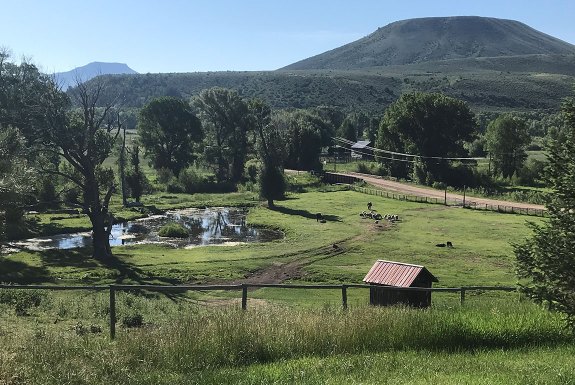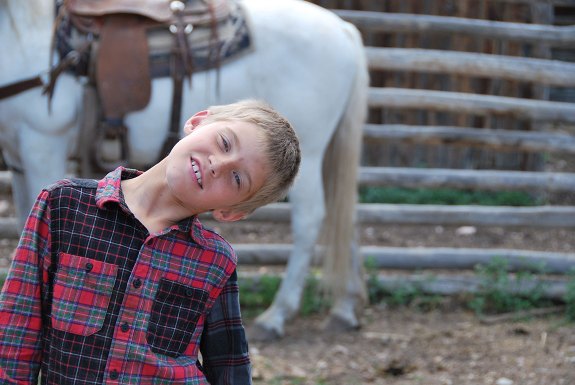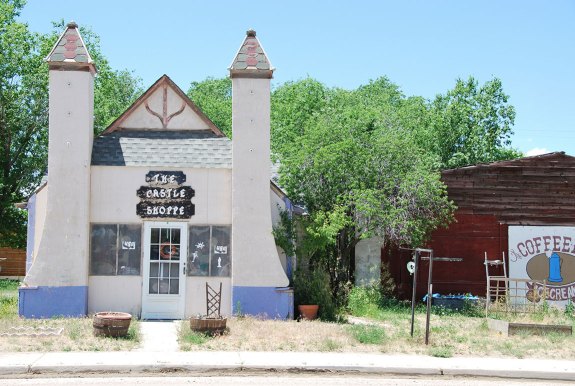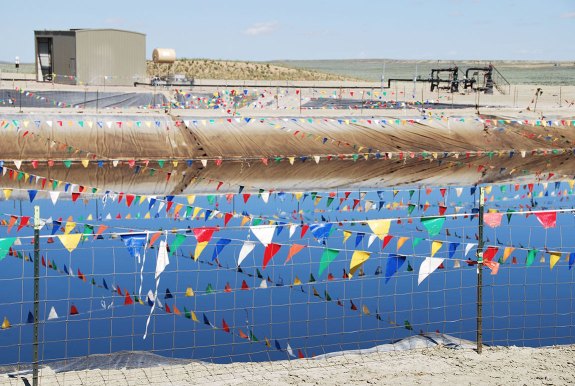Pat O’Toole was on horseback the first time he observed the preposterous breeding ritual of the greater sage grouse. It was near dawn in the spring of 1977, the year he came to work at Ladder Ranch, his wife’s family operation on the Wyoming-Colorado border. As the Continental Divide lightened to the east, he watched dozens of male grouse—round, knee-high, with a vertical fan of dark tail feathers—bouncing across a clearing in the sage. The birds chased and sparred and stared, heaving their white chests to make odd bubbling noises, circling the smaller, brown-brindled hens with all of the swagger of a strongman at the gym. Every year since anyone could remember, sage grouse had returned to this clearing—called a lek—in the lambing pasture at the foot of Muddy Mountain. “Those birds had probably been there not just generations, but eons,” O’Toole said. “It was a magical thing.”
Nearly half a century later, sage grouse still wing in to Muddy Mountain to dance and mate. But the species is in trouble. Sage grouse once numbered in the millions across the North American West—“great flocks of the birds,” wrote the naturalist George Bird Grinnell in 1910, “which are usually so unsuspicious that they will stand for some time before taking alarm” in a flurry of lumbering flight. Today, scientists estimate that less than 10 percent of the greater sage grouse’s original population remains—a 2010 study counted between 200,000 and 500,000 birds across 11 Western states and two Canadian provinces. The birds have disappeared entirely from five states.
Without undisturbed expanses of sagebrush—the gnarled, bittersweet shrub found across the high desert—sage grouse cannot survive. “The sage and the grouse seem made for each other,” the naturalist Rachel Carson wrote in her seminal book Silent Spring. Sagebrush provides shelter, food and roost for the birds. Scientists call the sage grouse an indicator species, their survival a barometer for the health of more than 350 other creatures, such as pronghorn, mule deer, elk, pygmy rabbit and dozens of bird species, all adapted to the region’s long winters, blistering summers and unyielding wind.
But human activity creates significant challenges for the animals that depend on sagebrush habitat. Overgrazing in the 19th century facilitated the spread of noxious understory grasses that provide less cover for the grouse and can stoke fast-moving, destructive wildfires. Roads, fences, housing developments, electric transmission lines and an explosion of oil and gas activity has further fragmented and degraded the “sagebrush sea.”
In the late 1990s, conservationists realized sage grouse populations were in steep decline and petitioned to protect the bird under the Endangered Species Act. The move raised alarms across the West: An endangered species listing would bring severe limitations on grazing, mining, energy development, road-building and other activities on 173 million acres of public, state and private land. For years, the federal government, under pressure from those interests, delayed a decision on the matter. In the interim, industry interests, conservation groups and lawmakers have jockeyed over every move to protect the bird. Congress and Western state legislatures have proposed dozens of bills undermining or barring a listing; the Interior Department and U.S. Fish and Wildlife Service have delayed creating protections; conservation groups have sued again and again to compel them.
Caught in the middle is the sage grouse itself, a living, struggling symbol of the battle over how to balance preservation and development on Western land.
That battle is playing out not only in courts and legislatures, but also in remote places like the Ladder Ranch, where Pat O’Toole, his wife, Sharon, and their family have run livestock for going-on six generations. The ranch sits on the far outskirts of Savery, Wyoming (population 19), at the confluence of the Little Snake River and Battle Creek. It is, indeed, a place of confluence: One of the largest and most critical mule deer migration routes in the country crosses through the property; its riparian areas host droves of migratory birds. The ranch spans borders—the house stands in Wyoming, the driveway in Colorado. “The natural system is intact here,” said Pat O’Toole.
But due to many of the same forces threatening the sage grouse, he fears it will not stay that way.
When the explorer John Frémont traveled the Little Snake River watershed in 1844, he found it “more variously stocked with game than any part of the Rocky Mountains we had visited.” The area was hunting ground for a number of tribes—Sioux, Cheyenne, Crow, Arapaho—but home base for none. As a result, wildlife flourished. Thanks to the land’s isolation and continuity of ownership and use, it remains chockablock with wildlife: pronghorn, grouse, bear, bald and golden eagles, and the O’Tooles’ six grandchildren, who run nearly as wild as the animals.
Sharon O’Toole’s great-grandfather, A.W. Salisbury, arrived there in 1881, buying a herd of horses on the Mexican border and trailing up to the valley. The family moved into sheep and cattle around the time of the Great Depression. Sharon and Pat met in college, at Colorado State University—Pat had come from Florida on a track scholarship. Today he looks every bit the rancher: jeans and boots, white mustache and broad, sun-baked face; Sharon, who is also a poet and essayist, wears two long braids down her back. Both planned to study law at the University of Wyoming when, on the day school started, they gave up their spots and moved back to help Sharon’s parents run the ranch. Two of their three children, Meghan O’Toole Lally and Eamon O’Toole, also chose to work on the ranch after college.
Today, the family runs 7,000 sheep and 900 cattle on 14,000 acres of private property and roughly half a million acres of public land spanning two states, four counties, 150 miles. To supplement ranch income, the O’Tooles rent cabins to hunters and cyclists traversing the Continental Divide Trail, which travels 3,100 miles between Mexico and Canada, skirting the ridgelines to the east of Ladder Ranch. “We needed something to support more families on the ranch,” said Meghan, who manages the family’s recreation business.


Guests stay in an old homestead and cabins across the dirt road from the O’Tooles’ 1915 home, eating in the nearby cookhouse, where everyone gathers each morning to hash out each day’s improvised choreography of family, employees (shepherds from Peru, who spend much of the year in backcountry camps), trucks, and guard dogs (50 of them)—a messy, multigenerational, multicultural mix. “It’s six generations of putting things together from a 160-acre start,” said Pat.
It’s an all-of-the-above approach to the challenges of keeping a ranch intact, and it typifies this family that transcends typical Western politics and stereotypes: large-scale public-lands ranchers who are also devoted to conservation. Pat served as a Democratic representative in the Wyoming Legislature for six years and has set on state and federal working committees seeking to find consensus on important land-use issues; he, Sharon and the children are also involved with nonprofits devoted to protecting species and enhancing and restoring habitat on private and public land. The family placed conservation easements on 2,600 acres of their property to ensure the land won’t be developed or subdivided; they are in the process of protecting 5,300 more. “Landscapes are disappearing,” Pat said, “and a lot of people are realizing the value of it and coming together to make habitat as productive as possible.”
“What’s good for the bird is good for the herd,” Pat O’Toole likes to say.
There are all sorts of threats to wildlife. But the O’Tooles maintain that ranching, if done right, need not be one of them. Opponents of public lands ranching argue livestock are as grave a threat to struggling species like sage grouse as other activities. The O’Tooles have set out to prove that notion wrong. “Their grazing practices, their riparian area management practices, all these things clearly demonstrate that you can keep a working ranch, make a profit, put your kids through school, retire in a reasonable state, and still conserve and manage wildlife and fisheries,” said Ed Arnett, chief scientist at the Theodore Roosevelt Conservation Partnership. “They’re trying to do the right thing.”
Protecting wildlife means protecting habitat; well over half of the habitat in the West resides on private land. “You have to have a landscape big enough to maintain the biology,” Pat said. He believes ranching complements that goal. “Our vision is working lands. Cows, sheep, kids, dogs; also mule deer, sage grouse and other wildlife,” he said. “I think our ranch has enough provable data regarding conservation that I am confident that it’s a good model for the country.”
The O’Tooles hadn’t paid much attention to the sage grouse on their ranch until the late ’90s, when they learned the species might be listed as endangered. “Because of self-preservation,” Pat said, “I got involved as quickly as I could,” working with conservation and ranching advocacy groups.
In 2007, with a listing decision looming, the state of Wyoming, which houses the world’s largest sage grouse population, brought together a broad coalition of conservation groups, business owners, energy companies, federal and state land managers, politicians, and ranching interests to create a comprehensive policy to stanch the bird’s decline. “If we kept going the way we were, we were going to reach a tipping point,” said coalition member Paul Ulrich, director of government affairs at Jonah Energy, which runs oil and gas operations in sage grouse country. The state would have far less leeway in crafting its own policies if the bird were listed as endangered.
After months of negotiations, the group reached an agreement to limit surface disturbance—drill pads, wells, roads, hayfields, even invasive weeds and burn areas—and restore disturbed areas within core grouse habitat, while permitting more extensive development in less critical terrain. In 2015, the Obama administration announced a $60 million federal plan to manage grouse habitat along similar lines. In return, the administration scrapped the endangered listing for the sage grouse.
While the O’Tooles were not happy with certain stipulations, they embraced the plan’s larger goals and even advocated, successfully, to have the Muddy Mountain lek—the lambing pasture where Pat saw his first sage grouse—designated a core habitat area. Federal money has helped the family enhance the habitat, working to restore the grasses and forbs that made up the original understory, which benefits both grouse and domestic livestock. “What we did with sage grouse is how the Endangered Species Act was intended to be used,” said Brian Rutledge of the National Audubon Society, who served on the Wyoming coalition.
Some conservationists disagreed, however. “The 2015 sage grouse plans fell short of what the peer-reviewed science shows is necessary to conserve and recover greater sage grouse and the sagebrush ecosystem,” said Michael Saul, a senior attorney with the Center for Biological Diversity, an environmental group that sued to overturn the plans. Industry groups, along with the states of Utah and Idaho, also filed challenges, arguing that the plans were too restrictive. “What we saw were very draconian oil and natural gas restrictions that exaggerate the threat from oil and natural gas development and fail to account for protections we have already put in place,” said Kathleen Sgamma, of the Western Energy Alliance, an industry group.
The Trump administration, which has issued a call for energy dominance, prioritizing oil and gas development on public lands, concurred: Only two years after the original agreement went into effect, the administration set about dismantling it. In March, the administration released a plan that would reduce protections across more than 51 million acres of habitat and allow oil and gas companies more leeway in obtaining waivers and modifications across the bird’s range, eliminating entirely the most stringent core protections on nearly 9 million acres across the sagebrush steppe. “Our intent was not to throw out the plans, but to make them better respond to the needs on the ground,” Brian Steed, then acting director of the Bureau of Land Management, said in an interview with The Associated Press. “We’re doing that in a very careful way to ensure that the bird’s protections are still in effect.”


This fall, however, a federal judge in Idaho disagreed, granting a temporary injunction blocking implementation of the changes until the court makes a final ruling. “It is likely that these actions will cause further declines of the sage grouse under the weakened protections,” U.S. District Judge B. Lynn Winmill wrote in an Oct. 16, 2019, decision.
With or without revised plans, the current administration has disregarded many of the protections the 2015 plan put in place. A report issued by the National Audubon Society, The Wilderness Society and the National Wildlife Federation in July found oil and gas lease sales and drilling approvals in sage grouse habitat have doubled since President Trump took office. The number of acres leased per month in sensitive grouse habitat increased by a measure of 10, from 2,383 acres a month in the Obama years to 20,566 per month in the first two years of the Trump administration. In Wyoming, the BLM opened up lease sales across tens of thousands of acres of prime habitat 200 miles northwest of the O’Toole ranch, according to the Center for Western Priorities. It is an area scientists have come to call the Golden Triangle, because it is one of the densest and most robust populations of sage grouse remaining on Earth. “You wouldn’t believe that they would go into a place that unfragmented and offer up leases,” said Arnett of the Roosevelt Partnership. “But they did.”
Buying an energy lease doesn’t mean the area will certainly be drilled. But the BLM under Trump has also issued drilling approvals in priority habitat at a rate nearly seven times higher than Obama’s BLM. During the government shutdown last winter, the Interior Department recalled employees to process drilling permit applications even while other offices remained closed, issuing 267 new permits throughout the course of the 35-day shutdown, according to March 2019 reporting by CNN.
Oil and gas activity presents particular challenges for sage grouse because of their remarkable fidelity to their mating and nesting grounds. The males return each spring to the same ancestral lek where the birds have danced and mated for hundreds, perhaps thousands of years. Females establish nests within 500 yards of the previous year’s; their chicks settle within one to two miles of where they were born. “There is individual fidelity to a site and also generational fidelity,” explained Matt Holloran, a scientist who helped develop the 2015 federal plans.
Over recent decades, a number of once-pristine sage grouse nesting areas have been intensively developed for oil and gas, stippled with wells and their accompanying infrastructure: drill pads and drill rigs, containers and service huts, pipelines and solar panels, tank batteries, bulldozers, and semitrucks. The noise and pollution is hard on the birds; in addition, derricks and power poles create perches for airborne predators like ravens and eagles, and grouse will vacate habitat with tall structures. (For that reason, scientists believe they also avoid wind turbines and accompanying transmission lines.)
Energy companies note that many reserves can be accessed through directional drilling outside of critical grouse habitat. “We’re doing everything we can to protect sage grouse and allow development,” said Ulrich, of Jonah Energy, who maintains that Wyoming’s state protections remain strong, regardless of federal changes. “We still need to make sure we’re keeping our eye on the ball regarding sage grouse. We can’t afford not to.”
Taxes collected from the energy industry account for 75 percent of Wyoming’s state budget, funding the schools and paving the roads. “We know we need oil and gas, and it sustains our community,” said Sharon. Many ranch families also work in oil and gas on the side to make ends meet. But the administration’s push for energy development—and the energy companies’ rush to take advantage—threatens to destroy the delicate equilibrium that has persisted here for so many years in the harsh landscape of south central Wyoming. “What’s the right balance? I don’t know,” said Pat.
North of the O’Toole’s “home place,” there’s a 6-million-acre expanse of federal, state and private land known as the Red Desert. Each fall, the family trails their sheep there, from high-alpine terrain in Colorado’s Routt National Forest 150 miles north to a 300,000-acre shared winter pasture where the Continental Divide splits in two, creating a closed basin where the waters drain neither east nor west, but instead sink into alkaline lakes and disappear underground. The views there stretch toward infinity—undulating sage and chalky badlands, white-streaked with salts, the Wind River range looming blue on the horizon. Bands of wild horses and elk browse in the sage; pronghorn race past in buoyant, athletic bounds; the wind blows so hard that semitrucks along I-80 topple with chilling regularity. It’s fierce country, with its own stark beauty. “Look at this land. There’s so much of it,” said Pat. “It’s a big enough landscape to support all the biodiversity. Not just leks and sage grouse, but all the sagebrush obligates.”
Last year, the drill rigs arrived in the O’Tooles’ winter pasture. The energy companies mowed down swaths of sage to build roads and pipelines. Where there was once only sage and sky, well pads now jut in every direction, three-story drill-rigs and rocket-shaped flares shadowing holding ponds full of produced water that glimmer like steel and smell like a gas station. Colored pennants crisscross the pools’ surface to repel roosting birds. Compressors hum; well pumps click; trucks barrel noisily down brand-new roads already washboarded from use. They leave the sagebrush gray with dust in their wake. Where pipelines went in, the ground is now laced with halogeton—an invasive grass that can poison livestock—and cheatgrass, a noxious weed that spreads easily and stokes massive, habitat-destroying wildfires.
None of this was here two years ago.
Off the main living room of the O’Tooles’ house, there’s a study, piled high with paperwork and books, cowboy hats, sheepskin and cowhides. Sharon’s father was born in that room. He died 10 feet away, in the living room that looks out to the spot where his own grandfather first homesteaded in the 1880s, at the base of Squaw Mountain, a volcanic cone sliced with bedrock and covered in aspen trees.
In 2009, during the financial crisis, a cousin’s ranch at the mountain’s foot went up for sale. “It would have been a bunch of trophy homes,” Pat said, developers slicing the land into driveways and fences and power lines, more disconnected fragments. Instead, the O’Tooles scraped together funds and loans to buy the property. But the debt has been crushing.
Ranching on public lands is in decline—from 1953 to 2014, federal and state acreage open to grazing has declined by half, and regulators allow fewer animals to graze on the land that remains. This can be good for land damaged from years of overgrazing, but it poses yet another challenge for ranchers trying to stay afloat. The threats come from all corners. The last two winters have been hard on the O’Tooles: One of the driest winters on record, followed by one of the wettest, with snow piling so high that their sheep struggled to forage. Thanks to tariffs, trade wars and the fickle providences of the global marketplace, commodity prices have crashed. Equipment and fuel costs, meanwhile, continue to rise. There is grazing-permit paperwork, so much of it; there are the Byzantine visa processes required to secure their Peruvian herders, more grueling each year; there are the constant predations of coyotes, ravens, bears.
Much has changed across the West. But sage grouse have not. They do things the way they always have, dancing toward their future among the derricks and flares.
And then there is the challenge of coexisting with the sage grouse, a species on the brink. “What’s good for the bird is good for the herd,” Pat likes to say. Sage grouse and livestock both thrive in big, intact, connected habitat. But if we fail the bird and it is listed as endangered, the herd will suffer too, as will the life and livelihood the O’Toole family has built and maintained over six generations. “For me the bottom, bottom line is: Is this ranch surviving?”
Just before first light, Pat O’Toole steers his truck across an ephemeral stream and up to the Muddy Mountain lek. Four years earlier, an oil and gas company drilled three exploratory wells in the valley. The holes came up empty—so the land remains empty. Moonlit clouds skim the mountains. “The beauty of this system,” he said, “is that you have all the different pieces in profusion.”
There are six places where the sagebrush dance in this drainage, but this is the largest lek. In previous years, the O’Tooles have counted more than a hundred birds. This year, there were only 40. Scientists have made similar observations elsewhere. Sage grouse populations are cyclical and difficult to count, but for the third straight year, sage grouse numbers have dropped across the West—52 percent in Idaho; 33 percent in Nevada; 38 percent in Oregon; 44 percent in Wyoming. So many factors have aligned against the birds; so few work in their favor.
Much has changed across the West. But sage grouse have not. They do things the way they always have, dancing toward their future among the derricks and flares. “Our changes have occurred too quickly,” said Holloran, the scientist. “They don’t like what we’re doing out here.”
You can hear the grouse before you see them: thunking noises, like a hand hitting a thick balloon. As he approaches the lek, Pat shuts off the engine and headlights, and the birds reflect in the moonlight: strutting and preening, puffing and popping and hopping, dancing as they have for so long—year after year, generation after generation.

